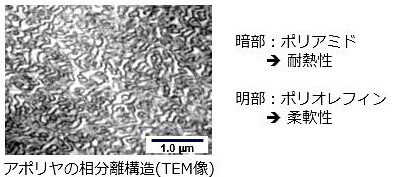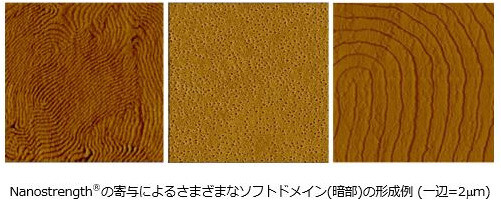New Products Incubator
Corporate R&D Products are advanced-material products based on the seed technologies of Arkema's R&D units. Many unique products have been developed and delivered using these technologies, for example precise polymerization technology based on the living radical polymerization technique; the morphological control technology at nano levels; the mass-synthesis technology for carbon nanotubes; the crystallinity control technology for super-engineering plastics; and the organic electronics technology using piezoelectric polymers. Through close collaboration with excellent partners and leading universities in Japan and other Asian countries, Arkema has been actively working to develop new applications in the automotive, electronics, and other industrial fields.
Piezotech®
Piezotech® is a PVDF (vinylidene fluoride)-based ferroelectric resin material.
It shows ferroelectricity, as well as pyroelectric and piezoelectric expressions. These features enable Piezotech® to be used as a sensor for various parameters, including pressure, oscillation, acoustics, temperature, and infrared rays. Moreover, Piezotech® can be applied to actuators, film speakers, ferroelectric RAMs, the driving parts of micromachines, and haptics. Future expansion of its application areas and the development of highly original applied products are limited only by the user's imagination.
While many ferroelectric materials are ceramic, Piezotech® is a resin, so its associated processability and flexibility fit well in printed and wearable electronics applications.
- FC Series: It has a large residual polarization and shows ferroelectricity after performing a polarization process. This grade is suitable for sensors.
- RT Series: It generates displacement according to applied voltage, with no need for polarization. This grade is suitable for actuators.

Apolhya®
Apolhya® is a thermoplastic resin produced by grafting polyamide onto polyolefin.
Using its unique graft technology, Arkema has created this new resin material that combines the properties of these very different resins that coexist at the nano level inside the material.
Features:
- Flexibility of polyolefin (modulus: 35-500 MPa)
- Thermal resistance of polyamide (melting point: 130-216 °C)
- Heat-aging resistance (time until tensile elongation rate weakens to a half-level: > 2000 hours at 150 °C)
- Adhesive properties (vs. PO, PA, TPU, PET, aluminum)
- Transparent grades (LC Series)

Applications:
- Resin modifiers (PE, PP, PA, PPS, etc.)
- Inner and outer layers of films and tubes
- Adhesion layers (PO/PA/TPU/PET)
- Wire coating materials (fire-retardant grades available)

Flexibloc®
Radical living polymer
Flexibloc® is a monodispersed polybutyl acrylate (PBA) that has a radical active group at its molecular end. By using Flexibloc® as a polymer initiator for polymerization, various types of block copolymers can be easily designed.
Features:
- Flexibloc® is a liquid polymer stable at room temperatures.
- Can be used in general-purpose radical-polymerization processes (bulk, liquid-solution, and suspension-polymerization processes).
- Wide range of monomer options (acrylic, methacrylic, and styrene monomers).

Nanostrength®
Controlled radical polymerization (CRP) acrylic block copolymer
Nanostrength® is an acrylic block copolymer with an ABA structure having polybutyl acrylate (PBA) as the soft constituent in the center block and polymethyl methacrylateof (PMMA) as the hard constituent in the side block. Nanostrength® is expanding its application areas as a new-concept impact modifier that allows for the introduction of soft components at nano levels.

Features:
- Block copolymer developed by Arkema's unique CRP technology
- Wide range of grades available (soft/hard composition, molecular mass)
- Modified grades available, such as highly polar groups, acid radicals
- Contains no metallic or halogen elements
- Easily soluble in epoxy, acrylic monomers, and other solvents
- Highly weather-resistant
Effects/benefits of the block structure
Modification of thermoset resin (epoxy, acrylic):
- Nano-level soft domain introduced into thethermoset material.
- Adds outstanding toughness while maintaining heat resistance.
Modification of thermoplastic resin:
- Improved impact resistance and elongation property
- Maintains transparency
- Improved chemical resistance
- High flowability

Examples of use:
- Impact modifier in epoxy and acrylic resins (structural materials, paints, adhesives, films, and electronic materials)
- Acrylic-resin modifier while keeping transparency
- Extrusion/injection molding




